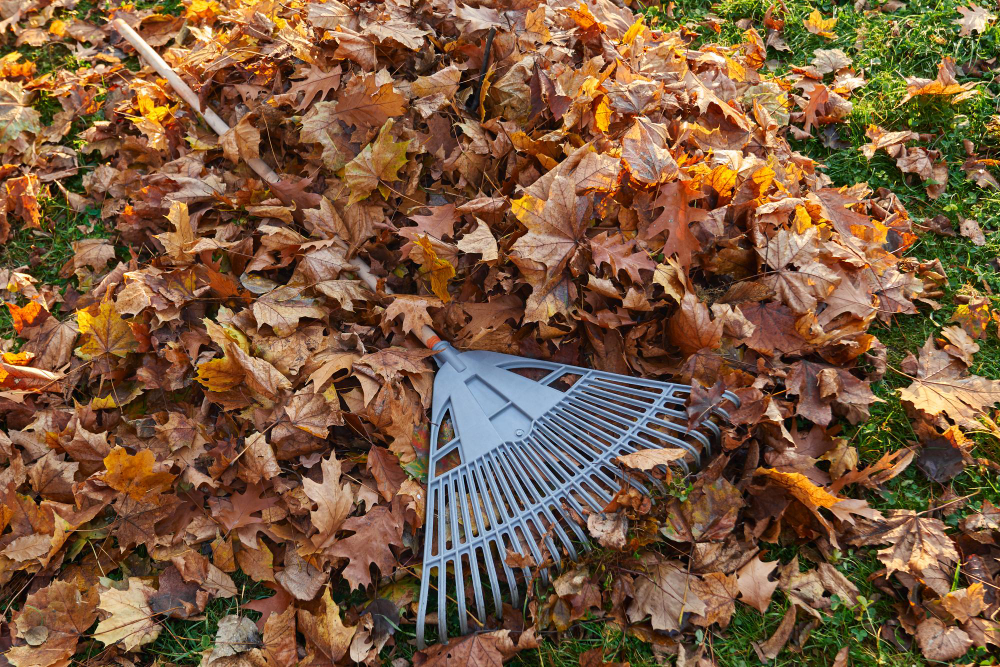- Lawn Turf
- Artificial
- Soil
- Timber
- Composite Decking
- Paving & Stone
Get In Touch With Our Experts Today!
Give us a Call! - Seed & Fertiliser
- Dressing
- Bark

October 13, 2025 Autumn TipsAutumn TurfLeavesTurf Tips
As the seasons change, you’ll begin to spot more deciduous trees dropping their leaves. But as their collection of brown, orange and red leaves gathers in piles, it leads to one question for gardeners and landscapers: what to do with fallen leaves on my lawn?
We see this problem every autumn. Although fallen leaves can bring turf challenges, they can also bring lots of opportunities to help boost turf health. In this article, we’ll cover the pros and cons of leaf cover on your lawn. As well as our top tips to manage leaf fall this autumn, to protect and promote a healthy winter lawn.
They can be. But depends on the types of leaves and how much of your lawn they’re covering. Small, thin leaves often decompose quickly, feeding your lawn rather than causing issues. They can also provide turf health benefits, such as:
However, you can’t let your leaves get on top of you. This is when the benefits can become detrimental, causing you serious turf problems!
If you leave leaves on your lawn, they will rapidly increase in density and lawn coverage. Too much leaf cover can lead to thick, wet leaf matting, resulting in big turf problems, such as:
If you’re concerned about turf pests and lawn diseases, we have a library of content to help you identify and resolve turf problems:
We’ve compiled our best practices for homeowners and professionals to help you manage fallen leaves and maintain a healthy lawn throughout autumn and winter.
Don’t wait until the leaves have already covered your lawn. Begin with regular clear-ups to make the task more manageable.
Being too aggressive with your leaf clean-up can cause harm to your lawn. To effectively remove leaves from your lawn, we recommend a tine lawn rake, leaf blowers, or a mulching mower for light leaf cover.
Look for dry days when leaves are dry, lighter and, therefore, easier to collect and break up. Avoid rainy days when leaves will be sodden. Also, avoid waterlogged or frozen lawns where turf will be more vulnerable.
Once you’ve removed fallen leaves from your turf, this is the perfect time to take advantage of a clear lawn. Assess the condition of your grass and look for areas that seem to be struggling – perhaps the grass is thinner here, discoloured or has developed bald patches. Aerate, top-dress and overseed these areas before winter fully sets in. Our blog on Winter Garden Care: Protect and Nurture Your Garden can help you out here.
Whether your lawn is struggling or not, after a post-leaf clear-up, consider applying an autumn/winter-based fertiliser like our Nourish lawn fertiliser. Autumn-based fertilisers often have higher levels of potassium to strengthen root systems and help grass endure winter stress. For more insights and top tips on grass fertiliser, head to our How and When to Fertilise Your Lawn and What Temperature is Too Cold to Fertilise My Lawn articles.
Yes! You can turn fallen autumn leaves into rich, organic and valuable fertiliser! Known as leafmould, it involves a slow and gentle decay process. Find a small, dark, and shaded area in your garden to create a leaf cage to collect your fallen leaves. You can also use perforated bin bags, which you can leave in your shed. Open them come spring and apply to your flowerbeds to help improve soil health. The texture of leafmould also aids with water retention, which is ideal for clay or sandy soils.
Top Tip: Make sure your leaves are dry before collecting them. For faster decay and improved oxygen and fungal activity, consider shredding the leaves before placing them in the cage or bag.
If you’ve noticed your turf is struggling due to increased leaf coverage, don’t hesitate to get in touch with our friendly team. We’ll provide the best advice to resolve the issue. We also have a host of helpful turf guides to keep your lawn in fantastic condition, no matter the season!
CALL US NOW ON 01234 818 253